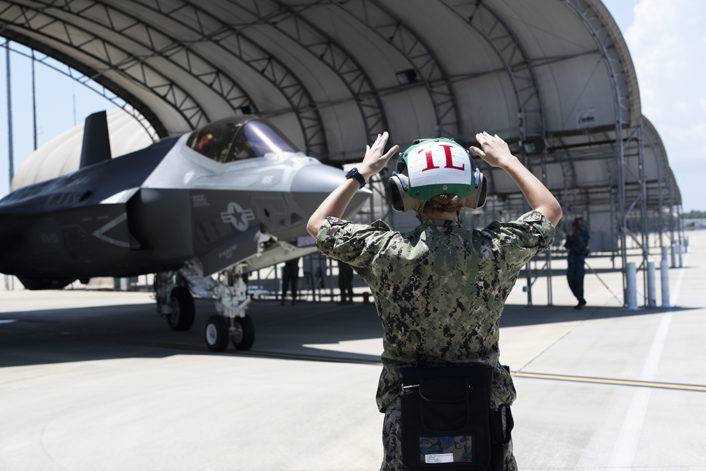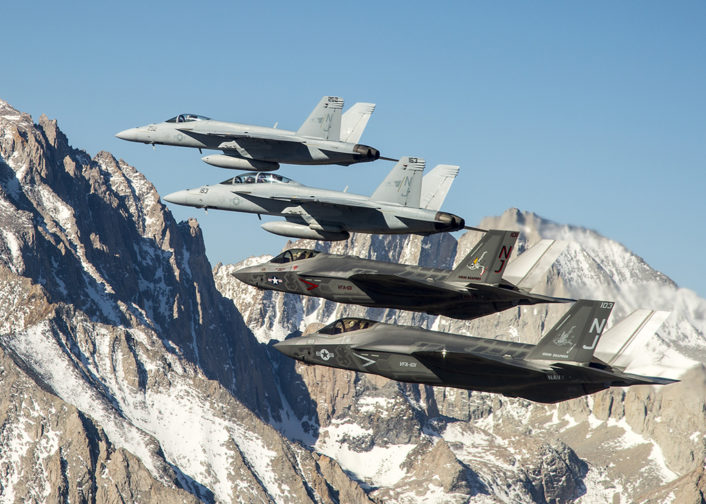The Navy is focused on getting the first operational F-35C squadron ready for deployment in 2021.
The US Navy deactivated one of its two F-35C Fleet Replacement Squadrons on May 23, 2019 in an effort to consolidate all its fifth-generation fighter activities at Naval Air Station Lemoore in California.
The VFA-101 “Grim Reapers” reactivated in 2012 as the very first F-35C squadron, based at Eglin AFB alongside the Air Force’s F-35As, and since then has trained more than 75 pilots and 1200 maintainers, flying nearly 11000 flight hours. The squadron will now join VFA-125, the other FRS squadron based in Lemoore. VFA-101 and VFA-125 already worked together last fall and winter, as their unification was in the works for about a year.
“We integrated VFA-125 maintenance practices into what we were doing, and then vice versa, VFA-101 into 125. We kind of took the best of everything, figured out what worked for everybody, and then came up with the best process,” said Cmdr. Adan Covarrubias, commanding officer of VFA-101 who will take command of VFA-125 next month.

The Initial Operational Capability (IOC) of the CATOBAR (Catapult Assisted Take Off But Arrested Recovery) variant of the Joint Strike Fighter was declared on February 28, 2019, after the first F-35C squadron, Strike Fighter Squadron 147, conducted aircraft carrier qualifications aboard USS Carl Vinson (CVN-70) and received its Safe-For-Flight Operations Certification.
The Navy added in an official statement: “In order to declare IOC, the first operational squadron must be properly manned, trained and equipped to conduct assigned missions in support of fleet operations. This includes having 10 Block 3F, F-35C aircraft, requisite spare parts, support equipment, tools, technical publications, training programs and a functional Autonomic Logistic Information System (ALIS). Additionally, the ship that supports the first squadron must possess the proper infrastructure, qualifications and certifications. Lastly, the Joint Program Office (JPO), industry, and Naval Aviation must demonstrate that all procedures, processes and policies are in place to sustain operations.”
The first operational squadron, VFA-147, is training for its planned 2021 deployment with Carrier Air Wing 2 aboard USS Carl Vinson. Capt. Max McCoy, commodore of the Joint Strike Fighter Wing in Lemoore, told USNI News that fully integrating the F-35s with the F/A-18 Super Hornets and EA-18G Growlers, as well as the E-2D Advanced Hawkeyes and the MH-60 helicopters in the air wing, is “absolutely critical” before the first deployment. Most of VFA-147’s pre-deployment workup process will be the same as any other squadron – starting with individual qualifications and squadron-level training, before moving to NAS Fallon for advanced training of the entire Carrier Air Wing ahead of joining the ships in the Carrier Strike Group.
“Our Navy and our nation need this aircraft now, and your efforts have been instrumental in getting us to this important moment in history. This is a historic moment, because for the first time in decades we could see the balance of power shift as China and Russia appear determined to reshape the world order”, said Rear Adm. Roy Kelley, commander of Naval Air Force Atlantic, to VFA-101 personnel during the deactivation ceremony, adding that “the F-35 is indeed the right aircraft at the right time.”
While the Argonauts of VFA-147 move into pre-deployment workups, the Marines of VMFA-314 will begin transitioning from the F/A-18A++ Hornet to the F-35C. The “Black Knights” will follow mostly the same transition process as VFA-147 did: the pilots will train with the Fleet Replacement Squadron in NAS Lemoore and the maintainers will conduct training both at Eglin Air Force Base and in Lemoore.

LEMOORE, Calif. (April 14, 2015) Two F-35C Lightning II aircraft fly in formation over the Sierra Nevada mountain range with to two F/A-18E/F Super Hornets from Naval Air Station (NAS) Lemoore. The flight is part of a six-day visit by the Grim Reapers of Strike Fighter Squadron (VFA) 101 to NAS Lemoore, the future basing site for the F-35C. The F-35C will complement the capabilities of the F/A-18E/F Super Hornet, which currently serves as the Navy’s premier strike fighter. (U.S. Navy photo by Lt. Cmdr. Darin Russell/Released)









